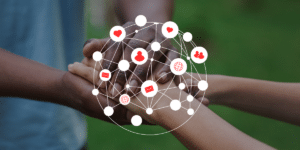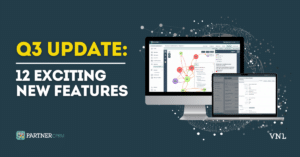Mobilizing for Action through Planning and Partnerships (MAPP) 2.0 is a revolutionary framework developed by the National Association of County and City Health Officials (NACCHO) that guides community health improvement. Building on its predecessor, MAPP 2.0 streamlines community-driven strategies to tackle public health challenges through shared missions and visions. This article will explore the MAPP 2.0 framework and illustrate how Social Network Analysis (SNA) can be a transformative tool in enhancing its implementation, contributing to the improvement of community health outcomes.
Table of Contents
MAPP 2.0: A Snapshot
MAPP 2.0 emphasizes community engagement, data-driven assessments, and a focus on health equity. It includes a continuous cycle that involves strategic planning, data collection and analysis, and community action, with an emphasis on community partnership and collaboration. It comprises three phases:
- Build the CHI Foundation: Laying the groundwork with strategic relationships, shared mission and vision, and a commitment to health equity.
- Tell the Community Story: A detailed community assessment utilizing three key assessment tools that recognize health inequities.
- Continuously Improve the Community: Implementing transformative strategies to address social determinants of health and promoting sustained action and continuous improvement.
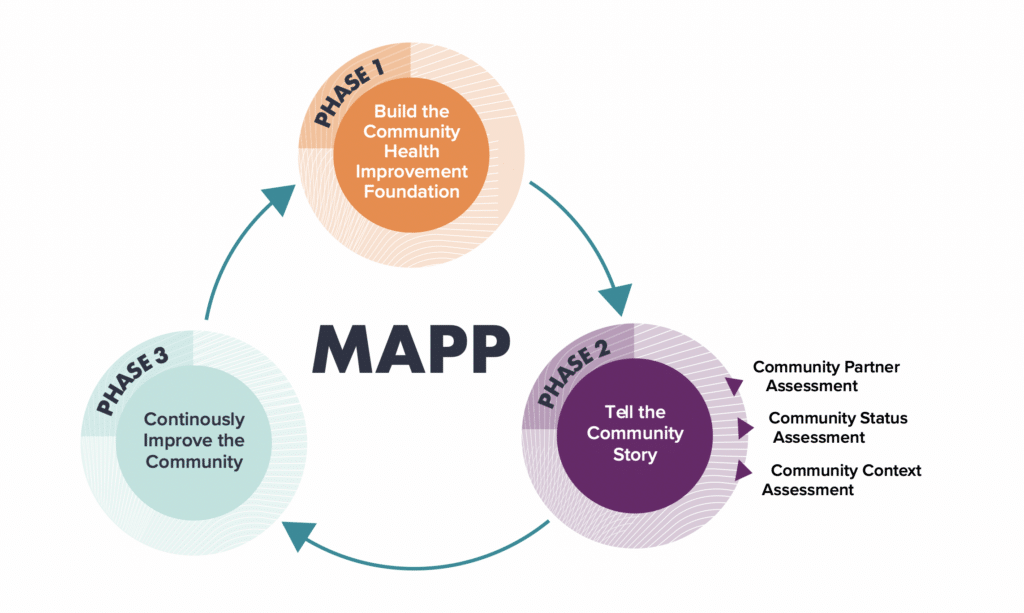
How Social Network Analysis (SNA) Enhances MAPP 2.0
Social Network Analysis (SNA) is a tool that visualizes and analyzes relationships within a community or organization. Here is a quick introduction to SNA, how it works, and what kinds of insight it provides:
Introduction to Social Network Analysis (SNA)
Social Network Analysis (SNA) is a methodological approach that has become increasingly vital in understanding complex community dynamics. It’s not just about social media or online connections; it’s a powerful tool that studies the relationships and interactions within a network of entities such as individuals, organizations, or even entire communities.
What is SNA?
SNA involves the mapping and measuring of relationships and flows between people, groups, organizations, computers, or other information/knowledge processing entities. It provides insights into the structure, dynamics, and complexities of the network, revealing essential patterns that might not be visible otherwise.
Insights Provided by SNA:
- Identifying Influencers: Pinpoints key individuals or organizations that hold significant influence within a network.
- Uncovering Hidden Connections: Reveals connections that might not be apparent, helping in understanding how information flows.
- Understanding Community Structure: Offers a visual representation of how various parts of the network interact, align, or diverge.
- Evaluating Network Health: Assesses the strength and weaknesses of relationships, allowing for targeted interventions.
How Is SNA Done?
SNA requires collecting data about the relationships between entities in the chosen network. This could be done through surveys, observations, or existing records. Once collected, this data is analyzed using specialized software to create visual maps or diagrams, quantifying relationships and evaluating the network’s overall structure.
With an understanding of what SNA is and what it can offer, it’s time to explore how this analytical approach can enhance the newly launched MAPP 2.0 Framework for Community Health Improvement.
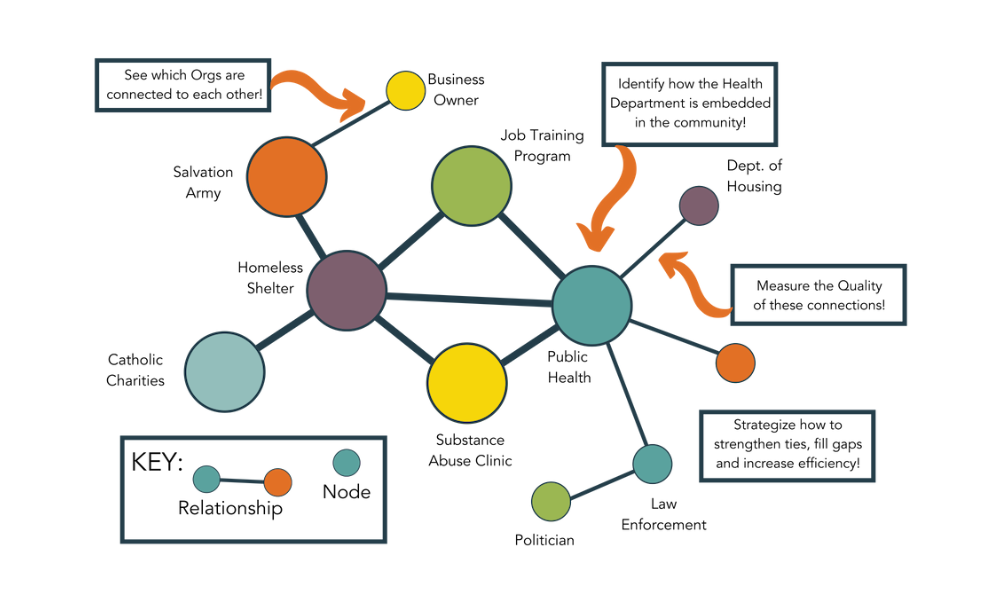

Get our monthly newsletter with partnership funding opportunities, news, and resources for cross-sector collaboration.
1. Strengthening Community Engagement (Phase 1)
SNA can identify key stakeholders and power structures within a community, helping to develop more targeted strategies for engagement.
For example, by visualizing the connections between different community partners, SNA can highlight influential members, thus assisting in creating tailored communication plans that foster collaboration.
Asking stakeholders about their perceptions of each entity’s influence and measuring their degree of connectedness across the community, we can provide numerous ways to visualize and validate power dynamics across partners. This helps ensure you include all the right stakeholders and partners at the table from the start during the overall MAPP planning, assessment, and implementation process.
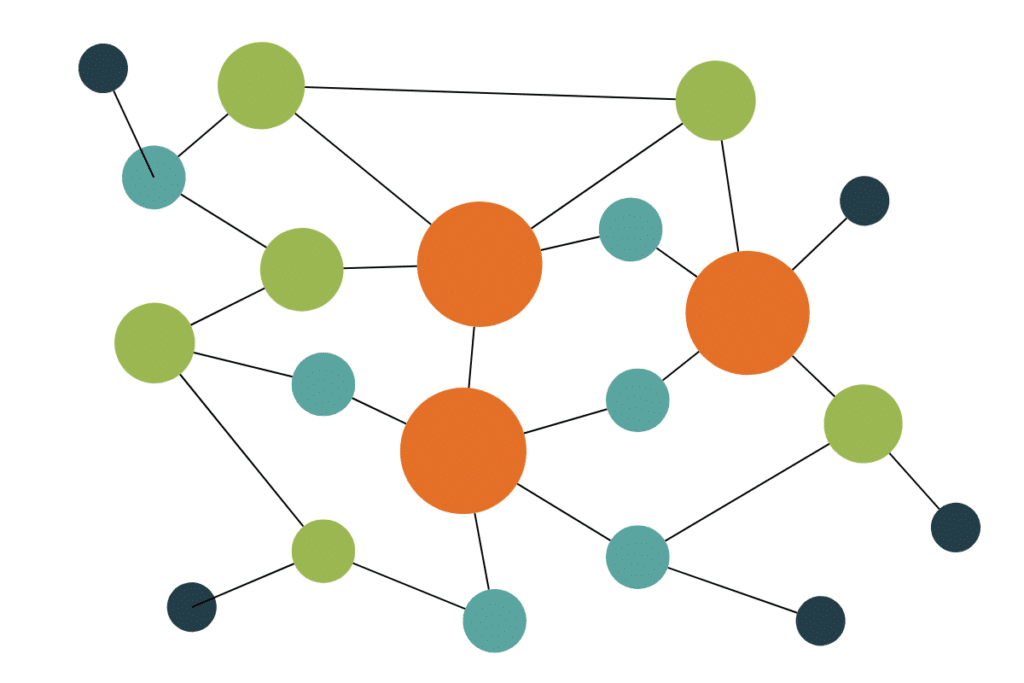
2. Enhancing Community Assessment (Phase 2)
The second phase in the MAPP 2.0 Framework involves three assessments to help you collect data, learn about the community context, and better tell the story of what is happening on the ground. These three assessments all include opportunities for enhancement with SNA.
- Community Partners Assessment (CPA): SNA can deepen the understanding of collective capacity across partners, identifying areas for growth and collaboration. It is the best way to objectively measure the community’s collective capacity among your network of partners to address health inequities by mapping the structure, frequency, and quality of your interconnections and interactions.
- Community Status Assessment (CSA): Through quantitative analysis, SNA provides insights into the underlying structures that may impact health inequities. Understanding how your local public health systems maps onto upstream social and environmental drivers of health can generate ideas for addressing gaps and eliminating redundancies.
- Community Context Assessment (CCA): SNA helps in mapping the qualitative insights and perspectives of individuals within the community, guiding improved system functionality. Viewing how personal lived experiences are influenced and fit within the broader system provides a powerful narrative for change.
3. Promoting Continuous Improvement (Phase 3)
SNA assists in formulating targeted interventions and monitoring their impact over time, allowing for continuous improvement in strategies aimed at health equity action. Consider this example: A community implementing a new health intervention can use SNA to track how information flows between partners, identify bottlenecks and gaps where communication gets stuck, and adjust strategies accordingly.
SNA can also help track how your work is changing the system, including both the structure of the system – who works with who – and the quality of those ties – how trust, value, and power flows through the system. This is a powerful tool for tracking progress and identifying changing priorities or opportunities as the network’s dynamics ebb and flow over time.
The Health Equity Action Spectrum & Strategy Bank
MAPP 2.0 provides visual tools and a repository of strategies to support community health improvement planning. SNA can enhance the application of these resources by:
- Visualizing the Relationship Between Actions and Outcomes: By connecting strategies from the Strategy Bank to real-world community networks, SNA creates a dynamic picture of how interventions may play out.
- Empowering Community Power Building: Through the Power Primer and SNA, communities can recognize and address power imbalances, fostering more equitable health outcomes.
Introducing PARTNER CPRM: A Tool to Enhance MAPP Implementation
The implementation of MAPP 2.0 with Social Network Analysis can be made seamless with the use of specialized tools like PARTNER CPRM (Community Partner Relationship Management). PARTNER CPRM is a cutting-edge platform designed to assist public health departments and coalitions in managing, mapping, and understanding their community ecosystem.
Utilizing the principles of SNA, PARTNER CPRM offers the following features:
- Mapping Community Relationships: Visually represent the relationships between various stakeholders, identifying key influencers and areas for collaboration.
- Monitoring Impact Over Time: Track the progress of community interventions, providing data-driven insights for continuous improvement.
- Integrating with MAPP 2.0: Tailored to support the implementation of the MAPP 2.0 framework, aligning with its focus on health equity and community engagement.
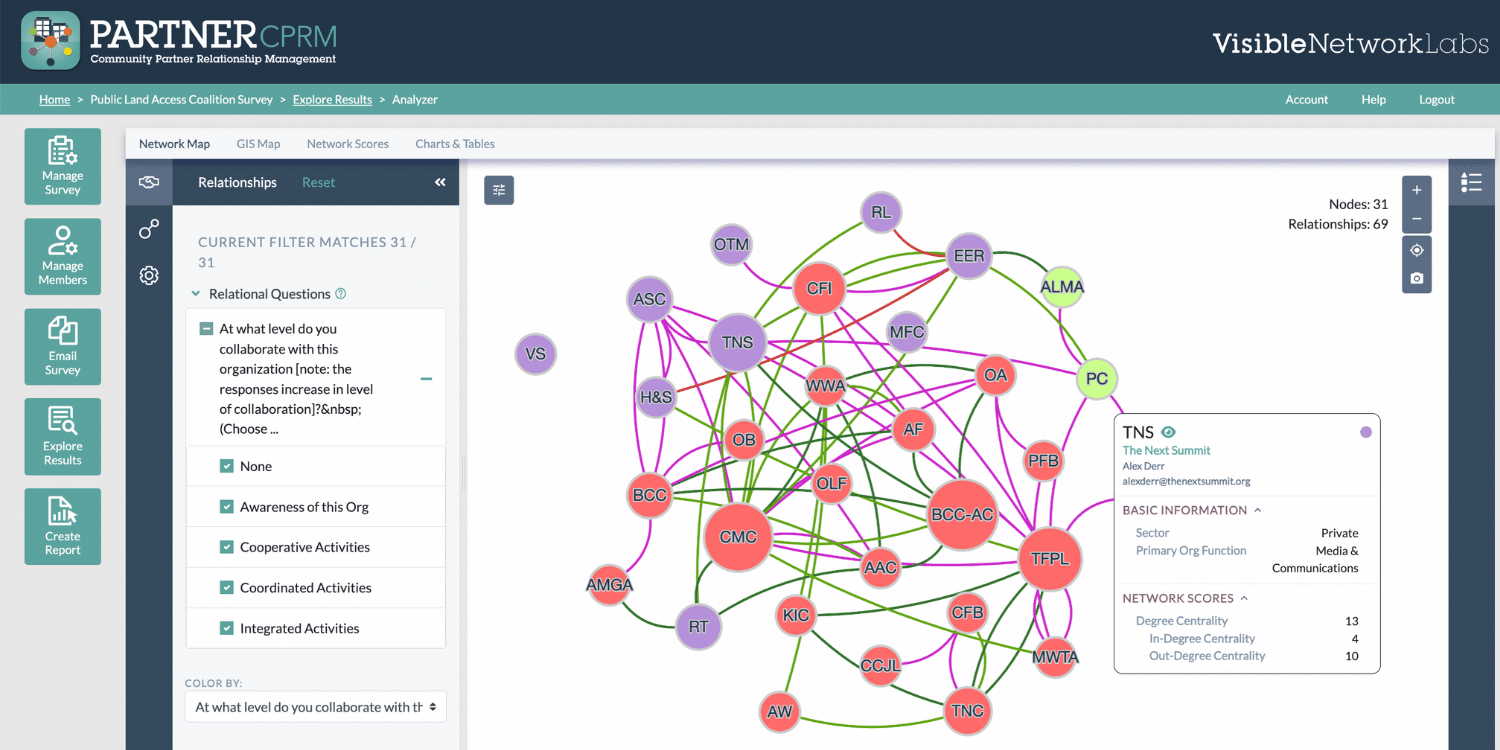
PARTNER CPRM stands as an ideal solution for those looking to harness the power of SNA within their MAPP implementation. Its robust functionalities align with the vision and goals of MAPP 2.0, providing an accessible and effective pathway to improve community health outcomes.
Learn More: Request a Demo
Are you ready to take the next step in enhancing your community’s health strategies through MAPP 2.0 and Social Network Analysis? Explore the capabilities of PARTNER CPRM and discover how this platform can revolutionize your approach. Request a demo today and embark on a transformative journey towards sustainable and equitable health solutions.
Social Network Analysis and MAPP 2.0: Now You Know
MAPP 2.0 Framework is a powerful tool for community health improvement, but its real potential is unlocked when integrated with Social Network Analysis. Through visualization, targeted engagement, and continuous monitoring, SNA brings a new dimension to the community-driven strategies that underpin MAPP 2.0. It enables communities to craft sustainable, data-driven, and equitable solutions, taking health improvement to the next level.

Get our monthly newsletter with partnership funding opportunities, news, and resources for cross-sector collaboration.
FAQs -MAPP 2.0 Framework and Social Network Analysis
Have a question we haven’t addressed yet? Leave a comment further below. Our team will get back to you with an answer as soon as possible.
A: MAPP 2.0 is a streamlined version of its predecessor, focusing on three phases instead of six and emphasizing community engagement, data-driven assessments, and health equity. It also introduces three new and revised assessment tools to better meet evolving public health needs.
A: SNA is a complementary tool to MAPP 2.0, providing visualization and analysis of relationships within a community. It enhances community engagement, offers insights during assessments, and supports continuous improvement in health equity actions.
A: Yes, MAPP 2.0 has been designed to be adaptable across various community types, including rural, urban, suburban, and tribal communities. Resources and tools such as SNA can be customized to suit the specific needs and capacities of different communities.
A: MAPP 2.0 includes the Community Partners Assessment (CPA), Community Status Assessment (CSA), and Community Context Assessment (CCA), focusing on understanding and addressing health inequities, social determinants, and community-specific contexts.
Work with our Team: Learn More!
At Visible Network Labs, we are always eager to delve deeper, explore further, and collaborate more effectively. If you’re interested in learning more about our work or how network science can benefit your organization, please reach out to us.


